Beef Cattle With a Bcs of 4
Author: Phil Scott BVM&South DVM&S DIPECBHM CERTCHP DSHP FRCVS
Reviewed: Phil Scott BVM&South DVM&S DIPECBHM CERTCHP DSHP FRCVS 2017
Published: 2010
This article adopts a five indicate BCS organization (1-5) with values subdivided into 0.five scores.
Notation that some other systems use a scale 1-9. It is therefore of import to know which system is being used.
Variations in moo-cow body status directly impact upon the reproductive performance of the herd, when failure to conceive is the nigh of import factor in reducing the overall sale cost of the weaned calf crop. Enquiry indicates that monitoring the BCS in club to keep cows in adequate condition throughout the production cycle can amend reproductive performance and positively impact the economics of the operation.
-
Achieving a BCS of ii.five or more than before calving and throughout the production cycle is the key to a assisting beef performance.
-
By sorting and feeding groups based on BCS, the economics of your farm improve.
-
Many farmers waste potential profits during the belatedly winter months by over-feeding cows in adequate condition when only part of the herd needs extra energy and supplementation. This situation would employ mostly to autumn-calving herds which are bred indoors from November onwards.
-
During the grazing season farmers need to pay attending to stocking rates and pasture quality because overstocking and poor forage quality tin lead to thin cows when spring-calving herds are housed.
-
Body status tin exist measured in the field without gathering or handling cattle.
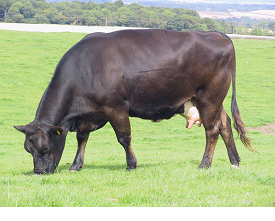
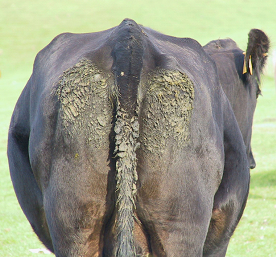
Achieving a BCS of 2.5 or more earlier calving and throughout the production cycle is the key to a assisting beef operation.
Central targets indicating high fertility performance in a beef herd with a nine week convenance period include:
- Arid cow rate ≤ five%
- Cows calved during the first 3 weeks of calving period ≥ 65%
- Weaned dogie percentage ≥ 94%
Few herds achieve these targets. Nutrition and an easy calving bull are the two most important factors.
Body condition scoring (BCS) method
The BCS organisation is relatively easy to learn and tin can be implemented in any farm state of affairs.
Body condition scoring (BCS) is a useful management tool for distinguishing differences in nutritional needs of beef cows in the herd. This system uses a numeric score to approximate body energy reserves in the cow. Research indicates that there is a strong link between the torso status of a cow and her reproductive operation. The percentage of barren cows, calving interval, and calf vigour at birth are all closely related to the body status of cows both at calving and during the convenance flavor. All these factors play an important office in the economics of your beef suckler herd. Monitoring body condition using the BCS organization is an important managerial tool for assessing production efficiency and is practised by all farmers but activeness may not always taken quickly plenty.
Body condition scores are excellent indicators of the nutritional status in beef cows. Ideal liveweight varies from cow to cow depending upon breed and milk yield whereas ideal trunk condition (BCS ii.5-3) is the same for all cows.
Body condition scoring and direction responses link together three major factors:
-
Skillful Beast Health and Welfare
-
Good Husbandry
-
Good Operation
Condition scoring is a technique for assessing the condition of livestock at regular intervals. The purpose of condition scoring is to achieve a balance between economic feeding, good production and good welfare. Condition scoring is particularly useful as an aid to dry moo-cow and pre-calving management with benefits during the subsequent breeding season. The objective is to ensure that cows calve down safely whether they are on a controlled nutrition indoors (leap-calving herd) or outdoors at grass (autumn-calving herd). Subsequently, during early lactation the cow may be under considerable nutritional pressure and torso condition is a vital indicator of excessive weight loss.
A moo-cow in 'thin' condition (BCS ane-2) is angular and bony with minimal fat over the backbone, ribs, hooks, and pins. There is no visible fat around the tail head or brisket.
A cow in 'ideal' condition (BCS 2.5-3.five) has a expert overall appearance. A cow with a BCS of 2.5 has visible hips, although there is some fatty over the hooks and pins and the backbone is no longer visible.
Cows with BCS of three or 3.5 go fleshy and the ribs are no longer visible. At that place is likewise fat effectually the tail head and in the brisket. An over-conditioned cow (BCS 4-4.five) is shine and boxy with bone structure hidden from sight or touch. She may have big protruding fat deposits (pones) effectually the tail head and on the pin basic. Exist enlightened that gut fill due to rumen contents or pregnancy can change the appearance of moderately fleshy cows, especially over the ribs or in front end of the hooks.
Visual indicators of each BCS are shown.
Trunk condition should be evaluated and recorded three times a year:
-
At weaning
-
60 days earlier calving
-
At calving.
By assigning BCS scores at the fourth dimension of weaning, the cows tin exist sorted for appropriate feeding/grazing. Grouping cows by feed requirements and feeding them accordingly can aid each of them accomplish BCS 2.v - 3 past calving. Scoring cows lx-xc days before calving allows you to evaluate your dry out cow nutritional program while allowing enough fourth dimension prior to calving for "extra feeding" if needed.
Cows that are sparse (BCS < 2) are non reproductively efficient and are more susceptible to wellness problems. Cows at BCS 1 need firsthand veterinary attending/investigation. Cows that are over-conditioned (BCS 4-iv.5) are the most plush to maintain and have often been barren for a flavor or failed to rear a calf.
2-year-olds with BCS iv-4.5 may experience calving difficulties due to the excessive fatty within the pelvic canal.
Failure to conceive is the nigh important factor contributing to the reduction of net calf crop. Formulation rates are dramatically compromised in cows that are BCS 2 or less.
Inquiry indicates that the body condition of a moo-cow influences days to first heat later on calving and calving interval. A beef cow must excogitate within 82 days of the birth of her concluding calf if she is to maintain a 12-month calving interval.
Percentage of cows in heat by 60 days post-calving depending upon BCS at calving
| Body condition | >2.five | 2 | <ane.5 |
| Per centum in estrus by twenty-four hour period 60 after calving | 91 | 61 | 46 |
How to Body Condition Score
Scoring consistently requires handling cattle in order to assess body reserves but an overall visual inspection is also important. The scoring system is designed to cover all cattle but some allowance should be made for different breeds.
The scoring method involves a manual assessment of the thickness of fatty cover and prominence of bone at the tail caput and loin area. You should stand directly behind the moo-cow to score both areas and always handle the animal quietly and carefully using the same hand.
The tail head is scored by feeling for the amount of fatty effectually the tail caput and the prominence of the pelvic bones.
The loin is scored by feeling the horizontal and vertical projections of the vertebrae and the amount of fatty in-between. Cess relies mainly on the tail caput only is refined past the loin score if both are very different. On a calibration of 1 - 5, a score of 1 is extremely thin and a score of 5 is extremely fatty. If possible, assess the scores to the nearest half point.
Consistency in the technique is the fundamental to expert condition scoring.
1 Poor
Tail head - deep cavity with no fatty tissue under skin.
Loin - spine prominent and horizontal processes sharp.
Pare fairly supple only coat condition oft rough.
BCS 1
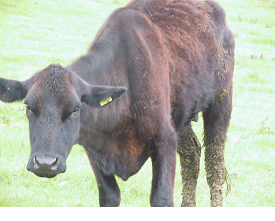
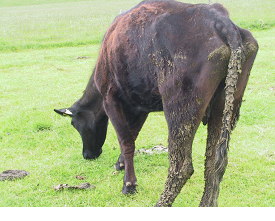
BCS 1.5
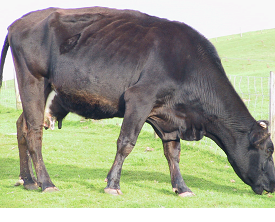
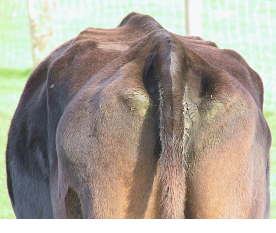
ii Moderate
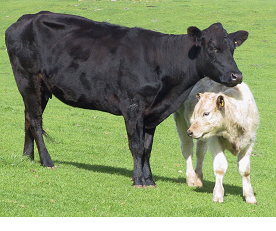
Tail caput - shallow cavity just pivot bones prominent; some fat nether peel.
Loin - horizontal processes can exist identified individually with ends rounded. Skin supple.
BCS 2.v
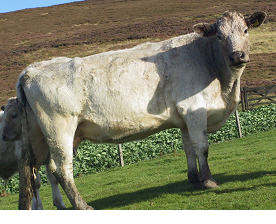
BCS 2.v
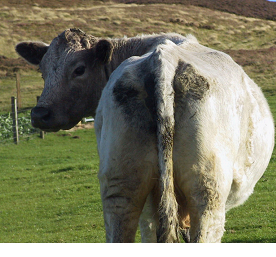
3 Skillful
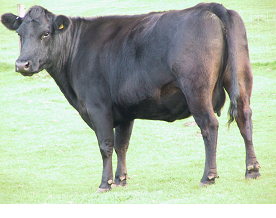
Loin - cease of horizontal process can simply be felt with pressure; only slight depression in loin.
Tail caput - fatty embrace over whole surface area and peel smooth but pelvis can be felt.
3.5
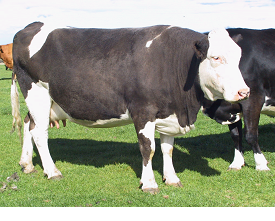
BCS iii.5
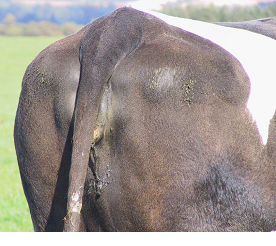
4 Fat
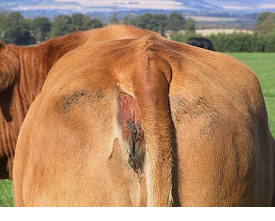
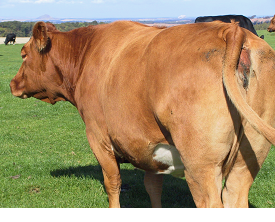
Tail head - completely filled and folds and patches of fat evident.
Loin - cannot experience processes and will take completely rounded appearance.
5 Grossly fatty
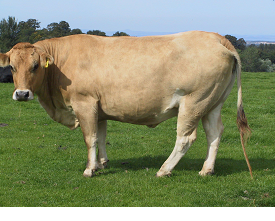
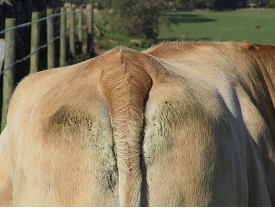
Tail head - buried in fatty tissue,
Pelvis - impalpable even with firm force per unit area in loin.
Source: https://www.nadis.org.uk/disease-a-z/cattle/condition-score-bcs-in-beef-herds/
Post a Comment for "Beef Cattle With a Bcs of 4"